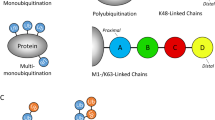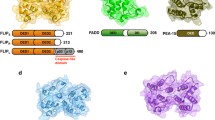Abstract
DEDD, a highly conserved and ubiquitous death effector domain containing protein, exists in non, mono, and diubiquitinated forms. We previously reported that endogenous unmodified DEDD is only found in nucleoli and that mono- and diubiquitinated DEDD associate with caspase-3 in the cytosol suggesting that ubiquitination may be important to the apoptosis regulating functions of DEDD in the cytosol. We now demonstrate that many of its 16 lysine residues can serve as alternative acceptors for ubiquitination to maintain the monoubiquitination status of DEDD. A central region in DEDD (amino acids 109–305) outside the death effector domain was found to be essential for ubiquitination and/or the docking of the ubiquitination machinery. Fusion of ubiquitin to the C-terminus of DEDD to mimic monoubiquitinated DEDD relocated DEDD from nucleoli to the cytosol. This fusion protein also demonstrated a greater apoptosis potential than unmodified DEDD. Finally, we show that both mono- and polyubiquitination of DEDD can be achieved by the cellular inhibitor of apoptosis proteins 1 and 2 (cIAP-1/2). In addition, the cotransfection of DEDD with cIAP-1 or cIAP-2 results in the relocalization of the IAPs to the nucleoli. Our data suggest that monoubiquitination of DEDD regulates both its cytoplasmic localization and its proapoptotic potential and that IAP proteins can regulate DEDD's ubiquitination status.
Similar content being viewed by others
References
Lee JC, et al. DEDD regulates degradation of intermediate filaments during apoptosis. J Cell Biol 2002; 158: 1051–1066.
Stegh AH, Peter ME. Apoptosis and caspases. Cardiol Clin 2001; 19: 13–29.
Dinsdale D, Lee JC, Dewson G, Cohen GM, Peter ME. Intermediate filaments control the intracellular distribution of caspases during apoptosis. Am J Pathol 2004; 164: 395–407.
Werlen G, Hausmann B, Naeher D, Palmer E. Signaling life and death in the thymus: Timing is everything. Science 2003; 299: 1859–1863.
Klumpp S, Krieglstein J. Serine/threonine protein phosphatases in apoptosis. Curr Opin Pharmacol 2002; 2: 458–462.
Freiman RN, Tjian R. Regulating the regulators: Lysine modifications make their mark. Cell 2003; 112: 11–17.
Lee JC, Peter ME. Regulation of apoptosis by ubiquitination. Immunol Rev 2003; 193: 39–47.
Yang J, Yu Y, Duerksen-Hughes PJ. Protein kinases and their involvement in the cellular responses to genotoxic stress. Mutat Res 2003; 543: 31–58.
Hicke L. Protein regulation by monoubiquitin. Nat Rev Mol Cell Biol 2001; 2: 195–201.
Li M, et al. Mono- versus polyubiquitination: Differential control of p53 fate by Mdm2. Science 2003; 302: 1972–1975.
Lotocki G, Alonso OF, Frydel B, Dietrich WD, Keane RW. Monoubiquitination and cellular distribution of XIAP in neurons after traumatic brain injury. J Cereb Blood Flow Metab 2003; 23: 1129–1136.
Deveraux QL, Reed JC. IAP family proteins–suppressors of apoptosis. Genes Dev 1999; 13: 239–252.
Huang H, et al. The inhibitor of apoptosis, cIAP2, functions as a ubiquitin-protein ligase and promotes in vitro monoubiquitination of caspases 3 and 7. J Biol Chem 2000; 275: 26661–26664.
Stegh AH, et al. DEDD, a novel death effector domain-containing protein, targeted to the nucleolus. EMBO J 1998; 17: 5974–5986.
Schickling O, Stegh AH, Byrd J, Peter ME. Nuclear localization of DEDD leads to caspase-6 activation through its death effector domain and inhibition of RNA polymerase I dependent transcription. Cell Death Differ 2001; 8: 1157–1168.
Roth W, Stenner-Liewen F, Pawlowski K, Godzik A, Reed JC. Identification and characterization of DEDD2, a death effector domain-containing protein. J Biol Chem 2002; 277: 7501–7508.
Alcivar A, Hu S, Tang J, Yang X. DEDD and DEDD2 associate with caspase-8/10 and signal cell death. Oncogene 2003; 22: 291–297.
Martin DA, Siegel RM, Zheng L, Lenardo MJ. Membrane oligomerization and cleavage activates the caspase-8 (FLICE/MACHalpha1) death signal. J Biol Chem 1998; 273: 4345–4349.
Treier M, Staszewski LM, Bohmann D. Ubiquitin-dependent c-Jun degradation in vivo is mediated by the delta domain. Cell 1994; 78: 787–798.
Nicoletti I, Migliorati G, Pagliacci MC, Grignani F, Riccardi C. A rapid and simple method for measuring thymocyte apoptosis by propidium iodide staining and flow cytometry. J Immunol Methods 1991; 139: 271–279.
Pickart CM. Mechanisms underlying ubiquitination. Annu Rev Biochem 2001; 70: 503–533.
Chen L, Smith L, Wang Z, Smith JB. Preservation of caspase-3 subunits from degradation contributes to apoptosis evoked by lactacystin: Any single lysine or lysine pair of the small subunit is sufficient for ubiquitination. Mol Pharmacol 2003; 64: 334–345.
Shin H, et al. Identification of ubiquitination sites on the X-linked inhibitor of apoptosis protein. Biochem J 2003; 373: 965–971.
Shih SC, Sloper-Mould KE, Hicke L. Monoubiquitin carries a novel internalization signal that is appended to activated receptors. Embo J 2000; 19: 187–198.
Terrell J, Shih S, Dunn R, Hicke L. A function for monoubiquitination in the internalization of a G protein-coupled receptor. Mol Cell 1998; 1: 193–202.
Qian SB, Ott DE, Schubert U, Bennink JR, Yewdell JW. Fusion proteins with COOH-terminal ubiquitin are stable and maintain dual functionality in vivo. J Biol Chem 2002; 277: 38818–38826.
King RW, Glotzer M, Kirschner MW. Mutagenic analysis of the destruction signal of mitotic cyclins and structural characterization of ubiquitinated intermediates. Mol Biol Cell 1996; 7: 1343–1357.
Hou D, Cenciarelli C, Jensen JP, Nguygen HB, Weissman AM. Activation-dependent ubiquitination of a T cell antigen receptor subunit on multiple intracellular lysines. J Biol Chem 1994; 269: 14244–14247.
Ott DE, Coren LV, Chertova EN, Gagliardi TD, Schubert U. Ubiquitination of HIV-1 and MuLV Gag. Virology 2000; 278: 111–121.
Robinson PA, Ardley HC. Ubiquitin-protein ligases–Novel therapeutic targets? Curr Protein Pept Sci 2004; 5: 163–176.
Haglund K, Di Fiore PP, Dikic I. Distinct monoubiquitin signals in receptor endocytosis. Trends Biochem Sci 2003; 28: 598–603.
Hicke L. A new ticket for entry into budding vesicles-ubiquitin. Cell 2001; 106: 527–530.
Patnaik A, Chau V, Wills JW. Ubiquitin is part of the retrovirus budding machinery. Proc Natl Acad Sci USA 2000; 97: 13069–13074.
Schubert U, et al. Proteasome inhibition interferes with gag polyprotein processing, release, and maturation of HIV-1 and HIV-2. Proc Natl Acad Sci USA 2000; 97: 13057–13062.
Strack B, Calistri A, Accola MA, Palu G, Gottlinger HG. A role for ubiquitin ligase recruitment in retrovirus release. Proc Natl Acad Sci USA 2000; 97: 13063–13068.
Wang Y, Satoh A, Warren G, Meyer HH. VCIP135 acts as a deubiquitinating enzyme during p97-p47-mediated reassembly of mitotic Golgi fragments. J Cell Biol 2004; 164: 973–978.
D'Andrea AD. The Fanconi road to cancer. Genes Dev 2003; 17: 1933–1936.
Garcia-Higuera I, et al. Interaction of the Fanconi anemia proteins and BRCA1 in a common pathway. Mol Cell 2001; 7: 249–262.
Gregory RC, Taniguchi T, D'Andrea AD. Regulation of the Fanconi anemia pathway by monoubiquitination. Semin Cancer Biol 2003; 13: 77–82.
Shmueli A, Oren M. Regulation of p53 by Mdm2: Fate is in the numbers. Mol Cell 2004; 13: 4–5.
Hu S, Yang X. Cellular inhibitor of apoptosis 1 and 2 are ubiquitin ligases for the apoptosis inducer Smac/DIABLO. J Biol Chem 2003; 278: 10055–10060.
Yang QH, Du C. Smac/DIABLO selectively reduces the levels of c-IAP1 and c-IAP2 but not that of XIAP and livin in HeLa cells. J Biol Chem 2004; 279: 16963–16970.
Ponnelle T, et al. Subcellular expression of c-IAP1 and c-IAP2 in colorectal cancers: Relationships with clinicopathological features and prognosis. Pathol Res Pract 2003; 199: 723–731.
Hofmann HS, Simm A, Hammer A, Silber RE, Bartling B. Expression of inhibitors of apoptosis (IAP) proteins in non-small cell human lung cancer. J Cancer Res Clin Oncol 2002; 128: 554–560.
Author information
Authors and Affiliations
Corresponding author
Rights and permissions
About this article
Cite this article
Lee, J.C., Wang, G.X., Schickling, O. et al. Fusing DEDD with ubiquitin changes its intracellular localization and apoptotic potential. Apoptosis 10, 1483–1495 (2005). https://doi.org/10.1007/s10495-005-1833-z
Published:
Issue Date:
DOI: https://doi.org/10.1007/s10495-005-1833-z




